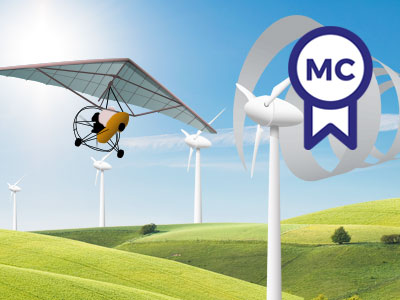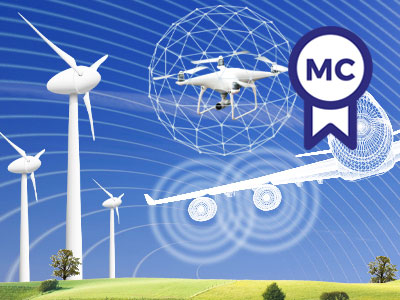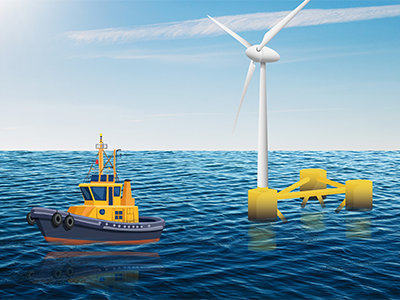Overview
Course video
Gain a technical overview of the engineering disciplines involved in wind farm design, operation and maintenance. Learn how to integrate successfully.
Offshore wind energy is a fast growing renewable energy technology that is built upon the expertise of several engineering disciplines. Engineers who work in wind farm design, operation and maintenance must understand the various disciplines involved in order to meet energy production and cost reductions goals. This is equally true of professionals who are new to this field.
Note: the number of seats for this course is limited and allocated on a first-come, first-served basis.
Practical case study
This course was designed with the needs of working professionals in mind. It focuses on how the various engineering disciplines integrate in the design and installation of offshore wind farms. At its core is a practical case study of the design, construction and operation of an offshore wind farm. Each learning week will focus on a particular discipline, examining issues and challenges such as external conditions, installation logistics, dynamics, grid integration, operation and maintenance.
Experts of various disciplines
The content will be delivered by experts of various disciplines who specialize in offshore wind farms:
- wind energy experts will cover aerodynamics, power production, and wake effects;
- electrical engineering experts will touch upon connection to the grid and electricity conversion;
- civil and mechanical engineering experts will cover the various support structure topologies and respective interactions with the soil.
The course presents video lectures, readings, quizzes and assignments. You will have the chance to interact with other professionals in the field and share knowledge and experience through online forums.
The course will help professionals in the field of offshore wind energy to broaden their knowledge of the relevant technical disciplines and their integration. Professionals with a scientific background, who are new to the field of offshore wind energy, will benefit from a high-level insight into the technical and engineering aspects of wind energy.
After completing this course, you will be able to:
- Understand how the various technical disciplines interact with one another.
- Be able to select the best options for developing and operating offshore wind farms.
- Grasp how wind turbines are designed to handle various conditions, such as dynamic wind and wave and loadings.
- Describe grid integration strategies for offshore wind turbines.
- Understand operational and maintenance strategies for offshore wind turbines and farms.
- Be able to cooperate more effectively with other technology partners active in the field and thus extend your professional network.
Details
Course Syllabus
Week 1: Brief history of modern wind turbines. Description of the main components of wind turbines. Aerodynamic principles of the conversion of wind energy into mechanical energy. Power curve and operational regimes.
Week 2: Origin and characteristics of wind, waves, and ocean currents. Wind velocity profiles and measurements. Weibull distribution and wave spectra. Hydrodynamic loads. Assessment of annual energy production.
Week 3: Dynamics of a single degree-of-freedom system. Outline of the degrees-of-freedom in wind turbines. Variation in wind turbine loading and dynamic amplification or reduction of loading system dynamics. Campbell diagram. Relevant failure modes for offshore wind turbines, with a focus on ultimate failure and fatigue. Commonly-used standards.
Week 4: Brief history of support structures for offshore wind turbines. Soft-soft, soft-stiff, and stiff-stiff designs. Estimation of the natural frequency of offshore wind turbines. Design and installation of monopiles. Fundamentals of offshore soil behaviour. Bearing capacity. Load‐transfer analysis of piled foundations.
Week 5: Types of electrical generators. Requirements for grid connection. Power balance. Basics of electromechanical energy conversion, power electronics, and gearboxes. AC and DC electrical infrastructures. Wind turbine wakes, their modelling and impact for offshore wind farm design.
Week 6: Operation and maintenance concepts. Reliability, accessibility, maintainability and serviceability analysis. Maintenance strategies, access Systems, and real-life availability of existing offshore wind farms.
Week 7: Submission of the main assignment on the design of an offshore wind farm.
Assignment(s) and Assessment
This course aims to convey the knowledge via online lectures, quizzes and exercises aim to practice the related skills. Collaboration and discussion with fellow online students are strongly recommended to improve the learning experience: you learn it best by explaining it others.
The quizzes consist of multiple-choice questions. Weekly exercises and quizzes are graded and mandatory to pass the course. Note that all deadlines are set at the end of the course, so you have some room to catch up if needed. (Access to the course materials will be given up to 6 months after the end date, but to earn the certificate all assignments and quizzes must be submitted before the communicated end date.)
Further reading (optional)
- J.F. Manwell, J.G. McGowan, A.L. Rogers, Wind Energy Explained: Theory, Design and Application, Wiley, 2nd Edition (2009)
- L.H. Holthuijsen, Waves in oceanic and coastal waters, Cambridge University Press (2007)
- B.W. Byrne, G.T. Houlsby, Foundation for offshore wind turbines, Phil. Trans. R. Soc. Lond. A 361, 2909–2930 (2003).
- Doherty, Gavin, Laterally loaded monopole design for offshore wind farms, Proceedings of the ICE - Energy, 165 (1): 7-17 (2011).
Qualifications
Certificates and CEUs
Professional education course with verified certificate.
The TU Delft Extension School offers Continuing Education Units for this course. Participants who successfully complete the course requirements will earn a Certificate of Completion and are eligible to receive 2.8 Continuing Education Units (CEUs).
Chartered Engineering Competences
All our online courses and programs have been matched to the competences determined by KIVI’s Competence Structure, a common frame of reference for everyone, across all disciplines, levels and roles.
These competences apply to this course:
- A1: Extend your theoretical knowledge of new and advancing technologies.
- E3: Undertake engineering activities in a way that contributes to sustainable development and a circular economy.
Admission
This course is primarily geared towards working professionals.
Prerequisites:
- Bachelor of Science or Engineering (BSc or BEng).
- Experience in the wind energy industry might be beneficial, although not mandatory.
Contact
If you have any questions about this course or the TU Delft online learning environment, please visit our Help & Support page.



